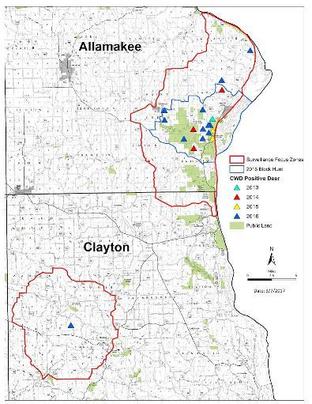|
March 16, 2017
Twelve Iowa deer test positive from 2016-17 hunting seasons
The DNR is closing the books on 2016 chronic wasting disease monitoring efforts, collecting 4,879 tissue samples from wild deer. From those, 12 samples tested positive for the disease; test results are pending on deer from a handful of counties, including a few dozen from a special deer collection effort in Clayton County.
“We are extremely grateful for the cooperation of hunters and landowners in the region who gave us samples and who allow hunters access to their property during the collection effort,” said Terry Haindfield, wildlife biologist with the Iowa DNR for a six-county region in northeast Iowa.
Chronic wasting disease first appeared in Iowa's wild deer herd in 2013. Each year since, the DNR has placed extra emphasis on finding the extent to which disease is in the area, and to help slow the spread by removing additional adult deer from the local population.
 What hunters can do to help
Haindfield said hunters play an important role in addressing CWD in Iowa. To help slow its spread, hunters should remove any mineral blocks and feeders that concentrate deer and increase the chances of spreading any disease. Hunters can also provide tissue samples to the DNR for testing, and report any sick or emaciated deer to the DNR.
“Deer hunting is one of Iowa’s great traditions. We want to educate and work with our hunters so we continue to have the best deer herd in the country for generations to come,” said Haindfield.
Learn more from the DNR Chronic Wasting Disease website.
|
Next steps for CWD
The Iowa DNR has a goal to collect around 5,000 deer samples each year from across the state. For the 14 counties near areas where CWD has been confirmed, quotas range from 50 samples to 500. The remaining counties have a quota of 15 samples each.
These CWD focus areas include: the northeast quarter of Pottawattamie County; Keokuk County; an area surrounding the four corners where Winnebago, Worth, Hancock and Cerro Gordo counties adjoin; Wayne, Appanoose, Davis, Wapello and portions of Monroe, Jefferson and Van Buren counties; and Winneshiek, Howard, Buchannan, Delaware, Scott, Clinton, Jackson, Dubuque, Clayton and Allamakee counties.
The disease has been found in southeastern Nebraska near the Missouri River, which will begin a new focus area along Iowa’s western border from Fremont to Woodbury County.
Special Collection Effort Results
Allamakee: Jan. 21 – Feb. 5
- 263 deer harvested
- 202 sampled (1 no sample)
- 60 fawns
- 125 permits
- 520 collectors (hunters)
- 928 tags
- 1 positive
Clayton County: Feb. 18 – March 5
- 158 deer harvested
- 138 sampled (86 results pending)
- 20 fawns
- 123 permits
- 456 collectors (hunters)
- 796 tags
- Zero positives so far
|
|
 |
Understanding the differences between two deer diseases in Iowa
According to Haindfield, Iowa hunters still have some confusion about the difference between chronic wasting disease and epizoic hemorrhagic disease. "We need to continue to explain the differences so our hunters are more knowledgeable if either disease does come into their area,” Haindfield said.
Chronic wasting disease is caused by a misshapen protein that is ingested by the animal from the environment, takes 18-36 months for clinical signs to show, and is always fatal. It has shown up in the wild deer herd in limited areas in the state. Epizoic hemorrhagic disease is spread by a biting insect (a midge), is often worse during drought years and can occur throughout Iowa. Find out more about deer diseases.

|